2016 JEEP GRAND CHEROKEE towing capacity
[x] Cancel search: towing capacityPage 532 of 723
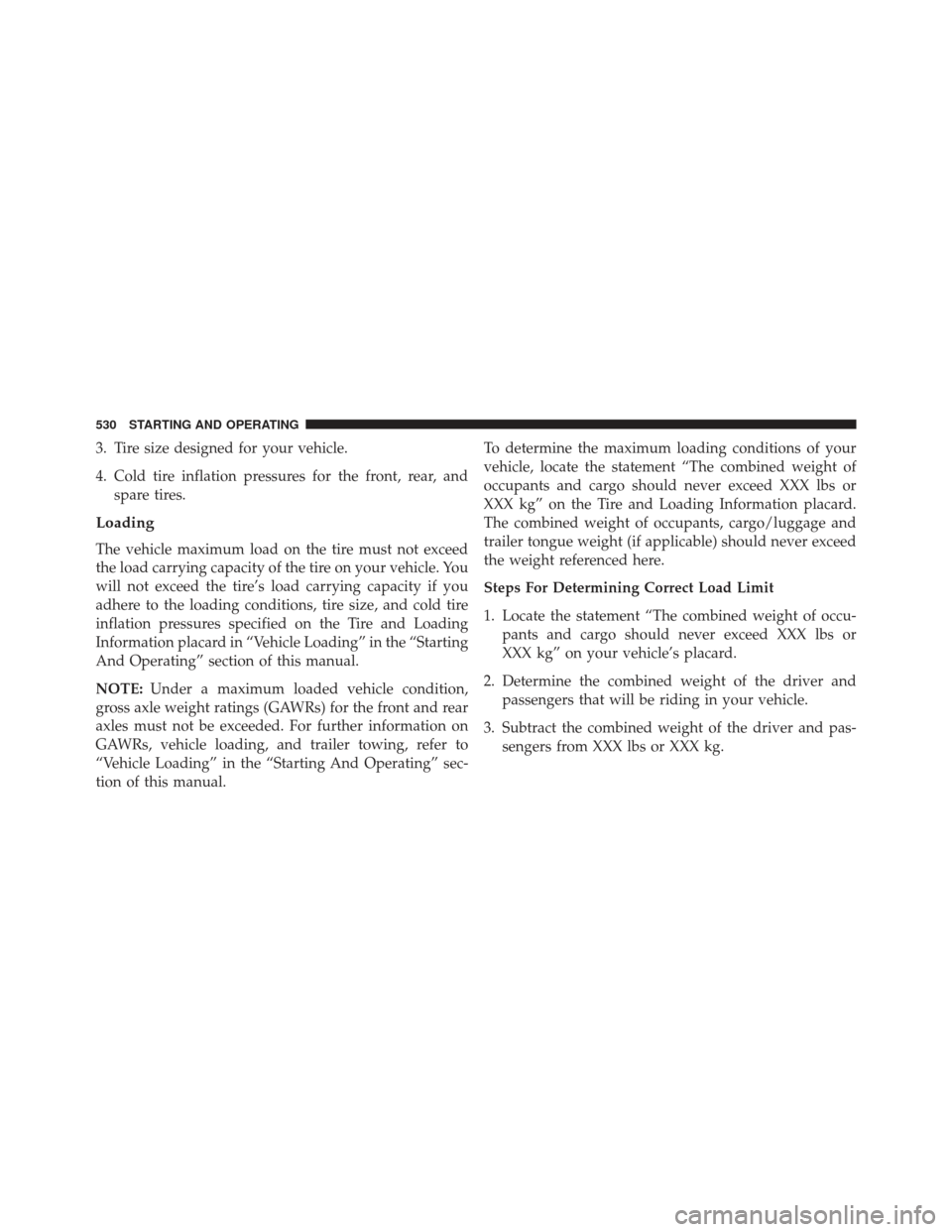
3. Tire size designed for your vehicle.
4. Cold tire inflation pressures for the front, rear, andspare tires.
Loading
The vehicle maximum load on the tire must not exceed
the load carrying capacity of the tire on your vehicle. You
will not exceed the tire’s load carrying capacity if you
adhere to the loading conditions, tire size, and cold tire
inflation pressures specified on the Tire and Loading
Information placard in “Vehicle Loading” in the “Starting
And Operating” section of this manual.
NOTE: Under a maximum loaded vehicle condition,
gross axle weight ratings (GAWRs) for the front and rear
axles must not be exceeded. For further information on
GAWRs, vehicle loading, and trailer towing, refer to
“Vehicle Loading” in the “Starting And Operating” sec-
tion of this manual. To determine the maximum loading conditions of your
vehicle, locate the statement “The combined weight of
occupants and cargo should never exceed XXX lbs or
XXX kg” on the Tire and Loading Information placard.
The combined weight of occupants, cargo/luggage and
trailer tongue weight (if applicable) should never exceed
the weight referenced here.
Steps For Determining Correct Load Limit
1. Locate the statement “The combined weight of occu-
pants and cargo should never exceed XXX lbs or
XXX kg” on your vehicle’s placard.
2. Determine the combined weight of the driver and passengers that will be riding in your vehicle.
3. Subtract the combined weight of the driver and pas- sengers from XXX lbs or XXX kg.
530 STARTING AND OPERATING
Page 533 of 723
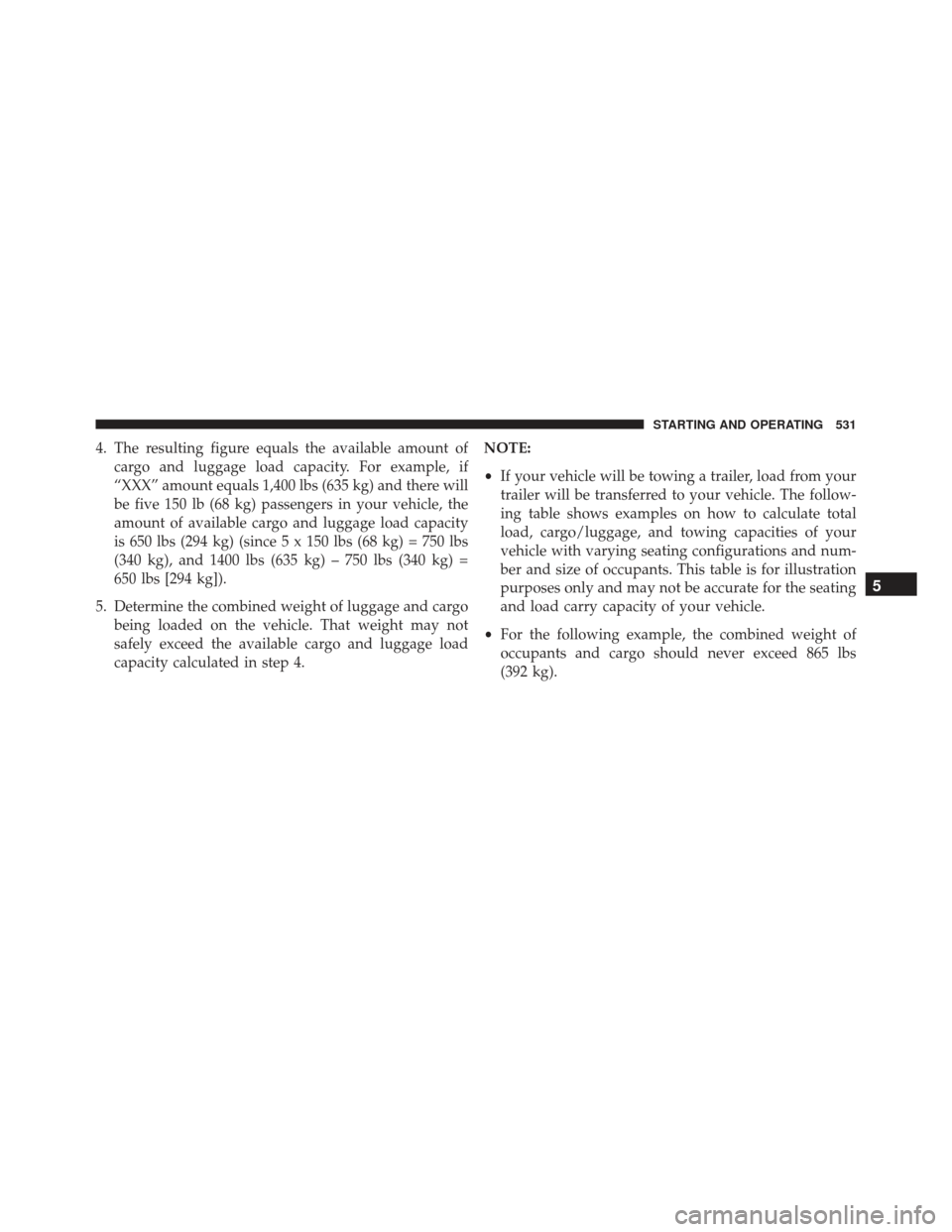
4. The resulting figure equals the available amount ofcargo and luggage load capacity. For example, if
“XXX” amount equals 1,400 lbs (635 kg) and there will
be five 150 lb (68 kg) passengers in your vehicle, the
amount of available cargo and luggage load capacity
is 650 lbs (294 kg) (since 5 x 150 lbs (68 kg) = 750 lbs
(340 kg), and 1400 lbs (635 kg) – 750 lbs (340 kg) =
650 lbs [294 kg]).
5. Determine the combined weight of luggage and cargo being loaded on the vehicle. That weight may not
safely exceed the available cargo and luggage load
capacity calculated in step 4. NOTE:
•
If your vehicle will be towing a trailer, load from your
trailer will be transferred to your vehicle. The follow-
ing table shows examples on how to calculate total
load, cargo/luggage, and towing capacities of your
vehicle with varying seating configurations and num-
ber and size of occupants. This table is for illustration
purposes only and may not be accurate for the seating
and load carry capacity of your vehicle.
• For the following example, the combined weight of
occupants and cargo should never exceed 865 lbs
(392 kg).
5
STARTING AND OPERATING 531
Page 549 of 723

NOTE:The premium Tire Pressure Monitor System will
automatically locate the pressure values displayed in the
correct vehicle position following a tire rotation.
The suggested rotation method is the “rearward-cross”
shown in the following diagram.TIRE PRESSURE MONITOR SYSTEM (TPMS)
NOTE: For vehicles equipped with run flat tires — When
the TPMS indicates a tire pressure of 14 psi (96 kPa) or
lower, always check tire pressure and replace the tire at
the first opportunity. At inflation pressure of/or below 14
psi (96 kPa) the tire is in the run-flat mode of operation.
In this condition, it is recommended a vehicle maximum
speed of 50 mph (80 km/h) for a maximum distance of 50
miles (80 km). The manufacturer does not recommend
using the run flat feature while driving a vehicle loaded
at full capacity or towing a trailer.
The Tire Pressure Monitoring System (TPMS) will warn
the driver of a low tire pressure based on the vehicle
recommended cold tire pressure.
The tire pressure will vary with temperature by about 1
psi (7 kPa) for every 12°F (6.5°C). This means that when
the outside temperature decreases, the tire pressure will
decrease. Tire pressure should always be set based on
Tire Rotation
5
STARTING AND OPERATING 547
Page 572 of 723
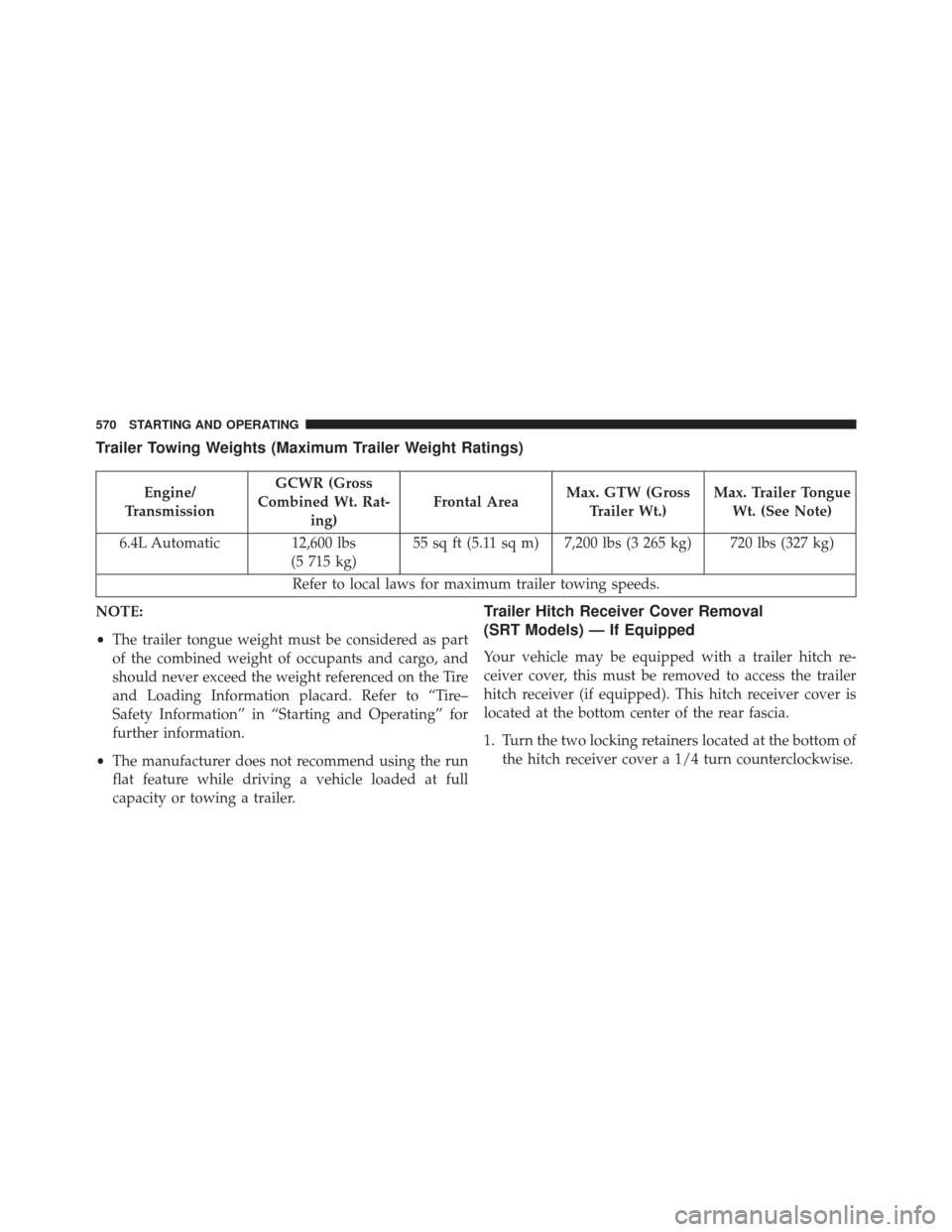
Trailer Towing Weights (Maximum Trailer Weight Ratings)
Engine/
Transmission GCWR (Gross
Combined Wt. Rat- ing) Frontal Area
Max. GTW (Gross
Trailer Wt.) Max. Trailer Tongue
Wt. (See Note)
6.4L Automatic 12,600 lbs (5 715 kg)55 sq ft (5.11 sq m) 7,200 lbs (3 265 kg) 720 lbs (327 kg)
Refer to local laws for maximum trailer towing speeds.
NOTE:
• The trailer tongue weight must be considered as part
of the combined weight of occupants and cargo, and
should never exceed the weight referenced on the Tire
and Loading Information placard. Refer to “Tire–
Safety Information” in “Starting and Operating” for
further information.
• The manufacturer does not recommend using the run
flat feature while driving a vehicle loaded at full
capacity or towing a trailer.
Trailer Hitch Receiver Cover Removal
(SRT Models) — If Equipped
Your vehicle may be equipped with a trailer hitch re-
ceiver cover, this must be removed to access the trailer
hitch receiver (if equipped). This hitch receiver cover is
located at the bottom center of the rear fascia.
1. Turn the two locking retainers located at the bottom of the hitch receiver cover a 1/4 turn counterclockwise.
570 STARTING AND OPERATING
Page 579 of 723
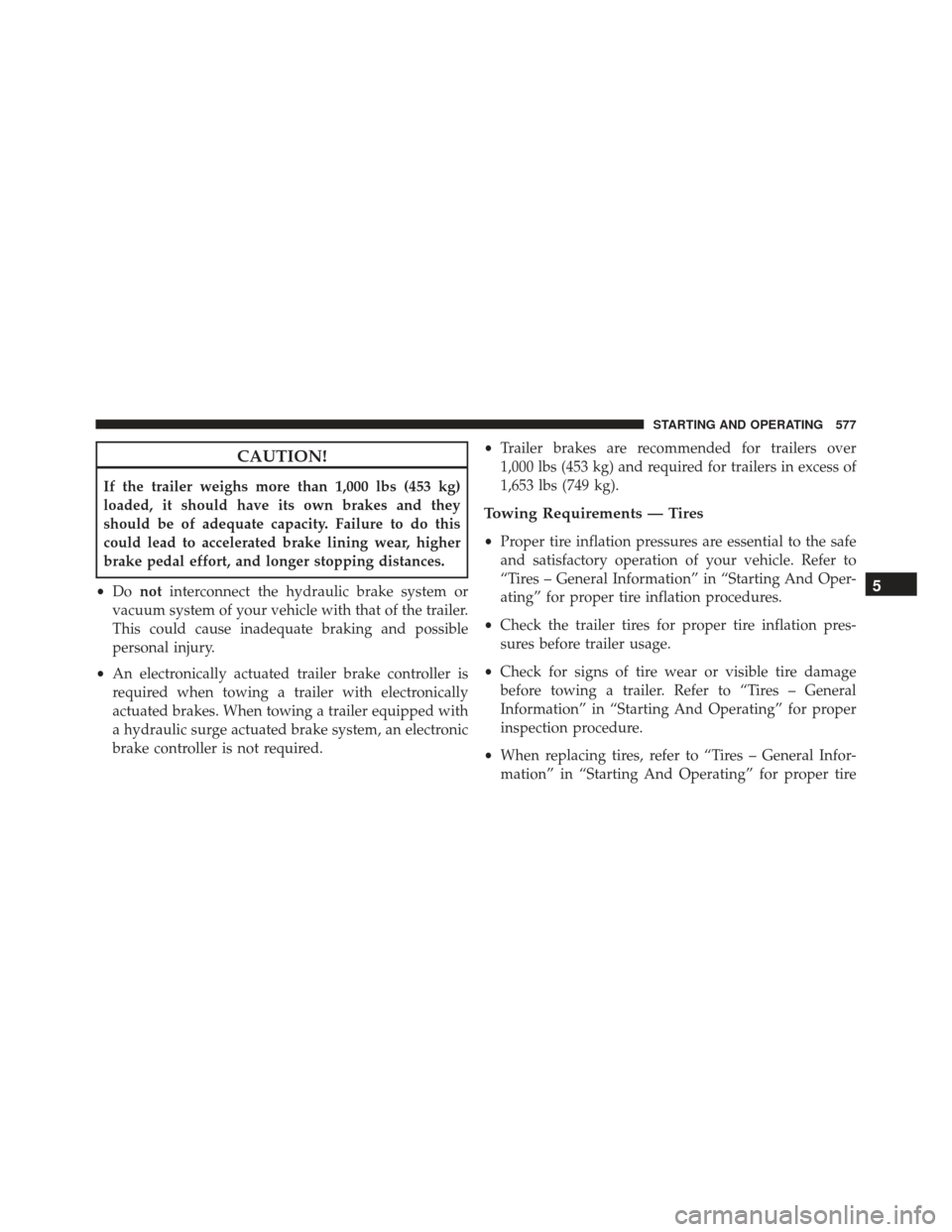
CAUTION!
If the trailer weighs more than 1,000 lbs (453 kg)
loaded, it should have its own brakes and they
should be of adequate capacity. Failure to do this
could lead to accelerated brake lining wear, higher
brake pedal effort, and longer stopping distances.
• Do not interconnect the hydraulic brake system or
vacuum system of your vehicle with that of the trailer.
This could cause inadequate braking and possible
personal injury.
• An electronically actuated trailer brake controller is
required when towing a trailer with electronically
actuated brakes. When towing a trailer equipped with
a hydraulic surge actuated brake system, an electronic
brake controller is not required. •
Trailer brakes are recommended for trailers over
1,000 lbs (453 kg) and required for trailers in excess of
1,653 lbs (749 kg).
Towing Requirements — Tires
• Proper tire inflation pressures are essential to the safe
and satisfactory operation of your vehicle. Refer to
“Tires – General Information” in “Starting And Oper-
ating” for proper tire inflation procedures.
• Check the trailer tires for proper tire inflation pres-
sures before trailer usage.
• Check for signs of tire wear or visible tire damage
before towing a trailer. Refer to “Tires – General
Information” in “Starting And Operating” for proper
inspection procedure.
• When replacing tires, refer to “Tires – General Infor-
mation” in “Starting And Operating” for proper tire
5
STARTING AND OPERATING 577
Page 580 of 723
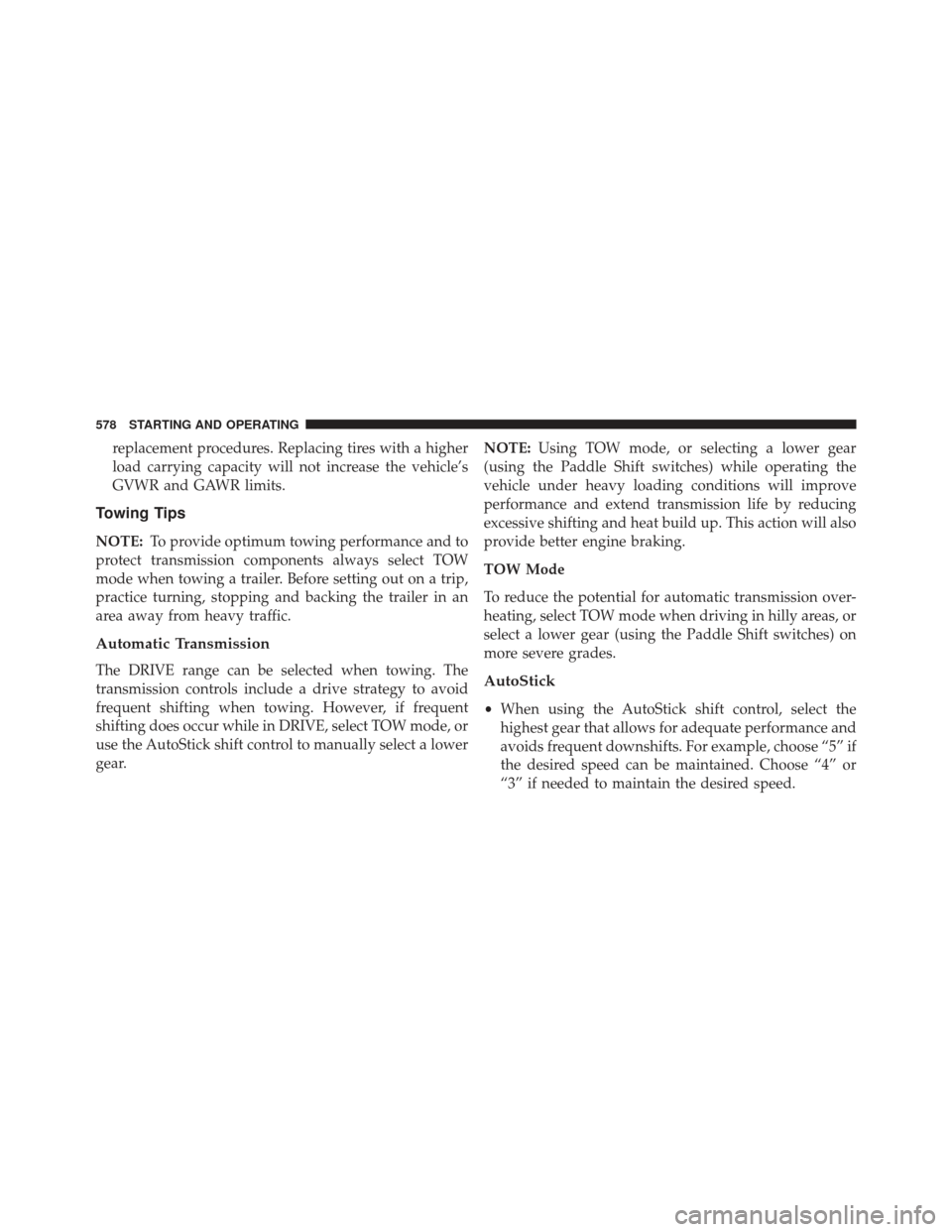
replacement procedures. Replacing tires with a higher
load carrying capacity will not increase the vehicle’s
GVWR and GAWR limits.
Towing Tips
NOTE:To provide optimum towing performance and to
protect transmission components always select TOW
mode when towing a trailer. Before setting out on a trip,
practice turning, stopping and backing the trailer in an
area away from heavy traffic.
Automatic Transmission
The DRIVE range can be selected when towing. The
transmission controls include a drive strategy to avoid
frequent shifting when towing. However, if frequent
shifting does occur while in DRIVE, select TOW mode, or
use the AutoStick shift control to manually select a lower
gear. NOTE:
Using TOW mode, or selecting a lower gear
(using the Paddle Shift switches) while operating the
vehicle under heavy loading conditions will improve
performance and extend transmission life by reducing
excessive shifting and heat build up. This action will also
provide better engine braking.
TOW Mode
To reduce the potential for automatic transmission over-
heating, select TOW mode when driving in hilly areas, or
select a lower gear (using the Paddle Shift switches) on
more severe grades.AutoStick
• When using the AutoStick shift control, select the
highest gear that allows for adequate performance and
avoids frequent downshifts. For example, choose “5” if
the desired speed can be maintained. Choose “4” or
“3” if needed to maintain the desired speed.
578 STARTING AND OPERATING
Page 719 of 723
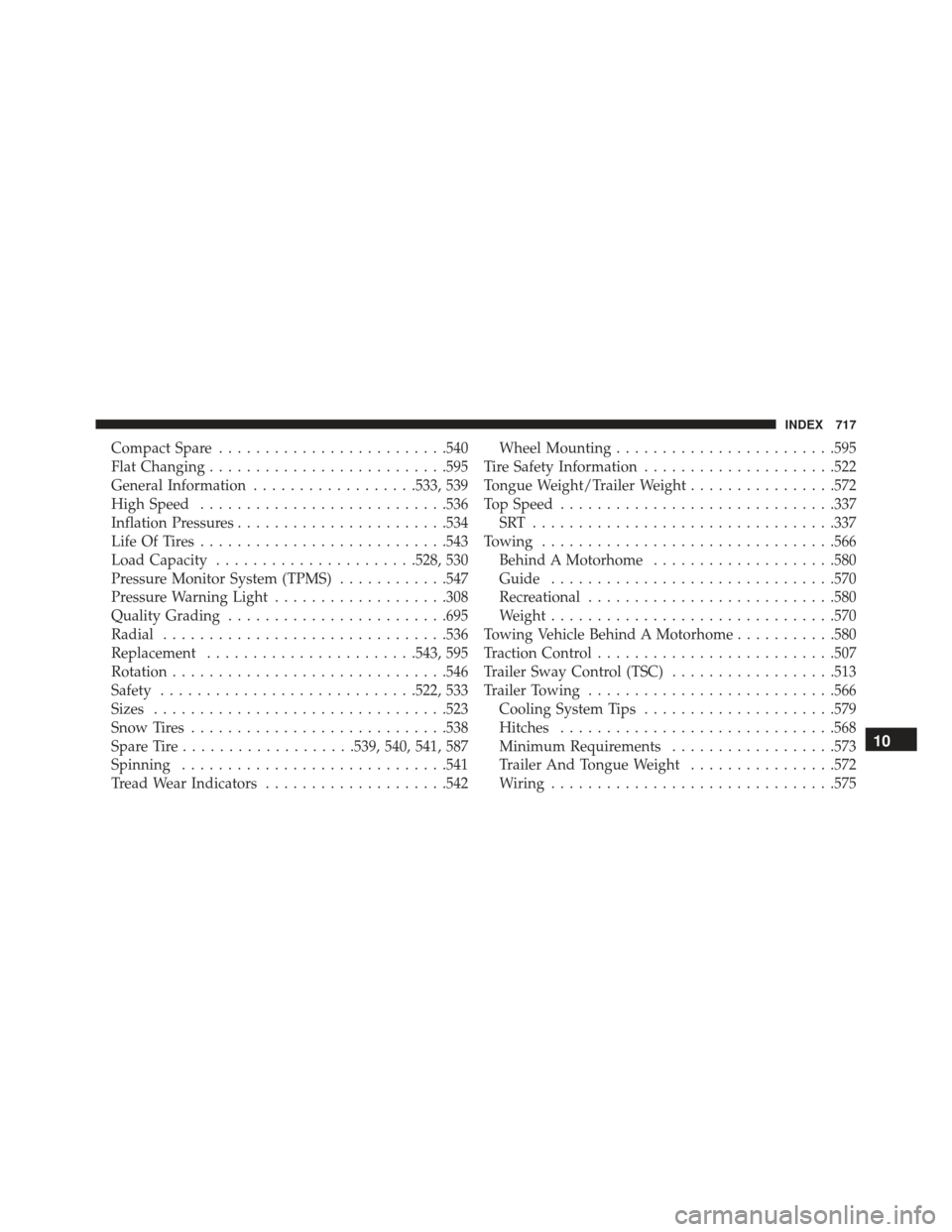
Compact Spare........................ .540
Flat Changing ......................... .595
General Information ..................533, 539
High Speed .......................... .536
Inflation Pressures ...................... .534
Life Of Tires .......................... .543
Load Capacity ..................... .528, 530
Pressure Monitor System (TPMS) ............547
Pressure Warning Light ...................308
Quality Grading ....................... .695
Radial .............................. .536
Replacement ...................... .543, 595
Rotation ............................. .546
Safety ........................... .522, 533
Sizes ............................... .523
Snow Tires ........................... .538
Spare Tire ...................539, 540, 541, 587
Spinning ............................ .541
Tread Wear Indicators ....................542 Wheel Mounting
....................... .595
Tire Safety Information .....................522
Tongue Weight/Trailer Weight ................572
Top Speed ............................. .337
SRT ................................ .337
Towing ............................... .566
Behind A Motorhome ....................580
Guide .............................. .570
Recreational .......................... .580
Weight .............................. .570
Towing Vehicle Behind A Motorhome ...........580
Traction Control ......................... .507
Trailer Sway Control (TSC) ..................513
Trailer Towing .......................... .566
Cooling System Tips .....................579
Hitches ............................. .568
Minimum
Requirements ..................573
Trailer And Tongue Weight ................572
Wiring .............................. .57510
INDEX 717